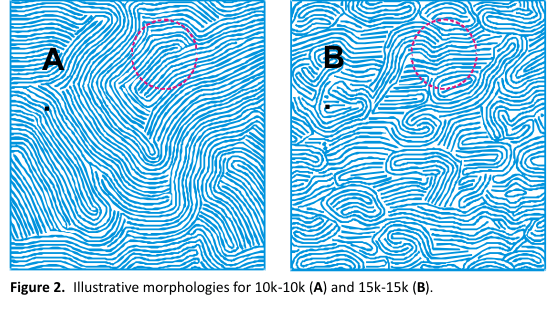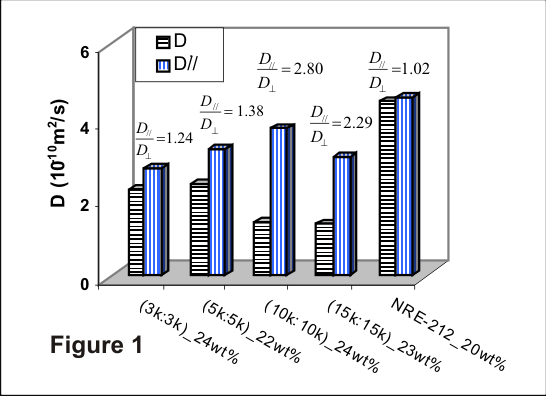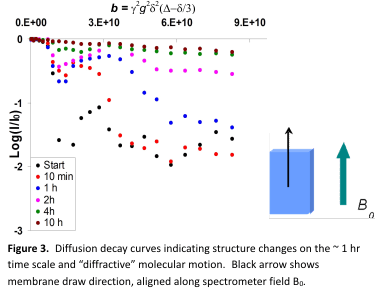Reports: G10
46727-G10 Solute Morphology And Transport In Polymeric Fuel Cell Materials
During the last year, the Madsen lab has undertaken three areas of research within this PRF-G project: 1) hydrophilic channel alignment in ionic polymer membranes including Nafion ® and sulfonated polysulfones, probed with 2H NMR spectroscopy, and 2) how diffusion of absorbed water and ionic liquids relates to this alignment, and 3) probing magnetic-field-induced dynamical morphology changes in swollen Nafion. We have developed new morphological models for channel alignment and defect structure in these ionomer membranes, and how this affects diluent transport. This fundamental information is guiding the way toward improved efficiency and reduced cost of hydrogen fuel cells, lightweight batteries, mechanical actuators, and water desalinization systems.
In areas (1) and (2), our explorations have focused on relating locally observed morphologies to water and proton transport. Multi-axis pulsed-field-gradient NMR yields diffusion anisotropy, the ratio of diffusion coefficients measured both in plane (D//) and through plane (D⊥). Figure 1 shows multi-axis NMR diffusion measurements on water in biphenyl sulfone (BPSH-BPS) hydrophilic-hydrophobic multi-block copolymer membranes, obtained from collaborator Prof. J. E. McGrath. These nanophase-separated membranes, so far explored with equal molar masses of hydrophilic (sulfonated) and hydrophobic (only aromatic) blocks, form a variety of morphological structures as probed with TEM and other methods. Notably, the higher block mass materials appear to exhibit lamellar morphologies with layer spacings ~ 30 nm from TEM measurements. This planar morphology is corroborated by our NMR measurements.
 Diffusion anisotropy
varies substantially with block mass, indicating substantial morphological
changes. As block mass increases,
diffusion anisotropy decreases with water uptake, in contrast to commercial Nafion 212 membrane, where
diffusion is always isotropic. We have also used 2H NMR quadrupole splittings on D2O
absorbed into these membranes to quantify molecular alignment and correlate
with diffusion anisotropy. The alignment
measured using D2O probe molecules accesses a length-scale of ~ 0.4
microns, whereas diffusion measurements access ~ 4 micron length-scale, giving
complementary access to defects and aligned structures. Both measurements are averaged over the membrane, giving an overall view of structure and
transport rather than a purely local one.
Diffusion anisotropy
varies substantially with block mass, indicating substantial morphological
changes. As block mass increases,
diffusion anisotropy decreases with water uptake, in contrast to commercial Nafion 212 membrane, where
diffusion is always isotropic. We have also used 2H NMR quadrupole splittings on D2O
absorbed into these membranes to quantify molecular alignment and correlate
with diffusion anisotropy. The alignment
measured using D2O probe molecules accesses a length-scale of ~ 0.4
microns, whereas diffusion measurements access ~ 4 micron length-scale, giving
complementary access to defects and aligned structures. Both measurements are averaged over the membrane, giving an overall view of structure and
transport rather than a purely local one.
Based on these multi-modal NMR results we conclude that, compared to 10k-10k, the average local ordering is higher in 15k-15k resulting in less variation in domain tilt angles, while the defect structure has higher density resulting in lower diffusion anisotropy. Figure 2 illustrates the key features of this morphogical model. These pictures emphasize tilt angles, domain sizes, and defect structure length scale for illustrative purposes.
Area (3) has involved close collaboration with Prof. Robert B. Moore at VT, where his group has provided drawn Nafion films in draw ratios of 1.5 4:1. After holding membranes with plane perpendicular to our 9.4 T spectrometer field, then reorienting them with draw direction along the field, these materials show time-dependent diffusion curves with time constants of ~ 1 hr, which indicate micron-scale reorientation of domains. Figure 3 shows curves of NMR signal intensity vs. gradient b factor. At long times, these curves are linear as expected for diffusion in uniform media. Shorter time curves illustrate the unexpected dynamics, which contain signatures of diffractive motion of water molecules, similar to those observed in porous media with well defined pore sizes and connectivities. Surprisingly, these films do not need to be plasticized and are macroscopically mechanically stable. We are currently probing these dynamics and morphological structures in order to understand and be able to manipulate this phenomenon. Further studies will entail application of plasticization solvents, and casting of films in high magnetic fields while observing development of anisotropy in situ.
This work has contributed to 13 presentations at regional (2), national (9), and international (1) meetings and invited university lectures (1) during this reporting period, a publication in Macromolecules, a publication in Soft Matter, and a paper under review in Macromolecules. We are preparing to submit another manuscript shortly introducing a quantitative model for anisotropy and diffusion in Nafion based on variably drawn membranes. We expect this work to have far reaching implications for membrane and device design.






